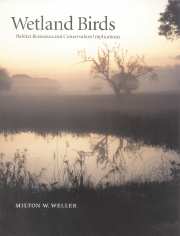Book contents
- Frontmatter
- Contents
- List of plates
- Preface
- Acknowledgments
- 1 Introduction
- 2 Wetlands: what, where, and why
- 3 Major groups of birds that use wetlands
- 4 Water and other resource influences
- 5 Foods, feeding tactics, strategies, and guilds
- 6 Bird mobility and wetland predictability
- 7 Other behavioral and physical influences on wetland living
- 8 Spatial and structural patterns
- 9 Habitat dynamics: water, plant succession, and time
- 10 Population consequences of wetland abundance and quality
- 11 How birds influence wetlands
- 12 Conservation implications
- 13 Measures of bird habitat use and quality
- 14 Current status and some conservation problems
- 15 Conservation and management strategies
- 16 Outlook
- 17 Epilogue
- Appendix 1 Scientific names of birds and bird groups
- Appendix 2 Scientific names of animals and animal groups other than birds
- Appendix 3 Scientific names of plants and plant groups
- Index of birds and bird groups
- Subject index
10 - Population consequences of wetland abundance and quality
Published online by Cambridge University Press: 02 October 2009
- Frontmatter
- Contents
- List of plates
- Preface
- Acknowledgments
- 1 Introduction
- 2 Wetlands: what, where, and why
- 3 Major groups of birds that use wetlands
- 4 Water and other resource influences
- 5 Foods, feeding tactics, strategies, and guilds
- 6 Bird mobility and wetland predictability
- 7 Other behavioral and physical influences on wetland living
- 8 Spatial and structural patterns
- 9 Habitat dynamics: water, plant succession, and time
- 10 Population consequences of wetland abundance and quality
- 11 How birds influence wetlands
- 12 Conservation implications
- 13 Measures of bird habitat use and quality
- 14 Current status and some conservation problems
- 15 Conservation and management strategies
- 16 Outlook
- 17 Epilogue
- Appendix 1 Scientific names of birds and bird groups
- Appendix 2 Scientific names of animals and animal groups other than birds
- Appendix 3 Scientific names of plants and plant groups
- Index of birds and bird groups
- Subject index
Summary
The influence of wetland characteristics on bird populations and species composition is a subject of esthetic, economic, and scientific importance, and, therefore, the subject of continuing research efforts. If wetlands are variable in number, size, and quality through either short-term or long-term changes, we expect variation in their attraction to waterbirds, differential success in nesting, feeding, or roosting, and, ultimately, differences in the abundance and variety of bird species using them. Numerous biologists have reported data supporting this pattern for various species, but estimates are rarely clear-cut nor conclusions simple because of the many variables that influence population estimates on a local area – especially when dealing with long-range migrants and diverse species. As a result, we must be cautious in accepting what seem like obvious conclusions when causative influences are so difficult to separate.
Water is the chief driver and figures prominently in most studies, some of which have been mentioned above. A common and seemingly logical assumption is that stable wetlands should have the greatest diversity of bird species and the largest numbers because of the predictability of resources. However, most studies and several summaries of information on wetland productivity indicate that diversity and populations of bird species are greatest in those areas with unstable water regimes (Mitsch and Gosselink 1993, Weller 1995). Fluctuations in water or even drawdown periods allow oxidation and enhanced biochemical processes that induce productivity. Food production may subsequently be elevated, but even then, other factors like food availability or concentration influence bird use. It is not surprising that bird populations and bird diversity seem related to the level of eutrophication (Nilsson 1978).
- Type
- Chapter
- Information
- Wetland BirdsHabitat Resources and Conservation Implications, pp. 165 - 182Publisher: Cambridge University PressPrint publication year: 1999



